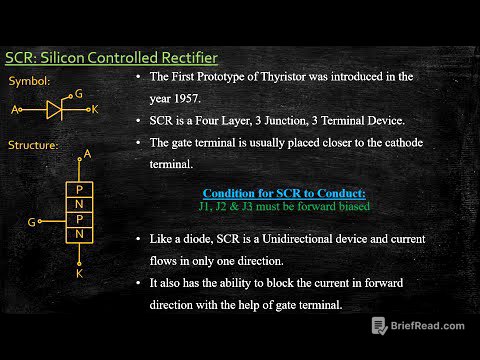TLDR;
Alright ji, so this full course is all about learning Python programming from scratch. You'll start with the basics, use an online IDE called Replit, and code a rock paper scissors game. Then, you'll dive deeper into Python's core features and finish by building a Blackjack game. The course focuses on hands-on learning with repetition of key concepts for a solid understanding.
- Learn Python basics with no prior experience needed.
- Code along using Replit and build two games.
- Understand core Python features and object-oriented programming.
Introduction to the Course [0:00]
The course is designed for beginners with no prior programming experience. It aims to teach the core aspects of Python, simplifying complex topics. Python is versatile, used in shell scripting, task automation, web development, data analysis, and machine learning. The course uses Replit, an online IDE, for easy coding and execution in a web browser. It includes a comprehensive section on Python features and culminates in coding a Blackjack game.
Setting Up Replit [0:58]
To start coding quickly, the course uses Replit, an online IDE. Users can sign up or log in to Replit and create a new Python replit. Replit allows coding and running programs in various languages within a web browser. The interface includes a code editor, output console, and file management. It also offers features like version control and a debugger, though these won't be covered in the course.
Creating Variables [3:11]
The course starts with creating variables for a rock paper scissors game. A variable named player_choice is assigned the string "rock". Variable names can include underscores for spaces, following Python convention. The = sign is the assignment operator. Strings are words or characters enclosed in quotation marks (single or double). The code will automatically replace the variable with it's value.
Functions in Python [5:50]
A function is a block of code that runs only when called. Indentation is crucial in Python; code indented the same amount is considered part of the function. A function named get_choices is defined using def, and the player and computer choice variables are indented within it. The return statement specifies what the function outputs when called.
Calling Functions and Printing [9:07]
To call a function, type its name followed by parentheses. An example function greeting is created to return the string "hi". To print the returned string to the console, the print function is used. The returned value from greeting is assigned to a variable called response, which is then printed.
Dictionaries in Python [12:31]
Dictionaries store data in key-value pairs, enclosed in curly braces. Keys and values are separated by commas. Keys can be strings or variables. A dictionary named choices is created with keys "player" and "computer", and their values are assigned to player_choice and computer_choice variables.
Getting Input from the User [15:37]
The input function gets input from the user. The input function is used to get the player's choice, prompting them to enter "rock", "paper", or "scissors". The entered value is stored in the player_choice variable.
Importing Libraries and Using Lists [16:52]
Python libraries are sets of useful functions. The import statement is used to import libraries, usually at the top of the program. A list in Python stores multiple items in a single variable, surrounded by brackets and separated by commas. The random library is imported to randomly choose an item from a list.
Creating the Check Winner Function [20:44]
A function named check_win is created to determine the winner. Functions can receive data through arguments specified inside the parentheses. The check_win function takes two arguments: player and computer.
If Statements [22:34]
An if statement checks a condition, and if true, executes the indented code block. Double equal signs == are used to check if two values are equal. The check_win function is updated to return "it's a tie" if player equals computer.
Concatenating Strings [25:39]
Strings can be combined using the + operator. An f-string is a simpler way to combine strings and variables by putting f at the beginning of the string and enclosing variables in curly braces {}.
Else and Elif Statements [30:16]
elif stands for "else if" and combines else and if. It checks a condition if the previous if condition is false. The program executes only one of the if, elif, or else blocks.
Refactoring with Nested If Statements [33:36]
Refactoring is restructuring code while maintaining its functionality to make it simpler or more understandable. Nested if statements are used to simplify the check_win function.
Calling the Functions to Play the Game [37:58]
The get_choices and check_win functions are called to play the game. The choices variable stores the result of calling get_choices, which returns a dictionary. The values of the "player" and "computer" keys are passed to the check_win function.
Setting Up Python Locally [43:52]
Python can be installed locally by downloading it from python.org. The download page provides instructions for different operating systems. Python programs can be run using an interactive prompt (Python REPL) or through a code editor like Visual Studio Code.
Using Visual Studio Code [45:32]
Visual Studio Code can be used to run Python programs by installing the Python extension. A new file is created, code is written, and the file is saved with a .py extension. The program can be run by clicking the play button, which opens a terminal window and executes the code.
Variables in Detail [48:44]
A Python variable is created by assigning a value to a label using the = sign. Variable names can include characters, numbers, and underscores but cannot start with a number. Certain keywords like if, for, and import cannot be used as variable names.
Expressions, Statements, and Comments [51:21]
An expression returns a value, while a statement performs an operation on a value. A program consists of a series of statements, each on its own line. Comments, indicated by a # symbol, are ignored by the Python interpreter.
Indentation and Data Types [53:19]
Indentation is meaningful in Python and must be consistent within a block of code. Python has built-in data types like strings (str), integers (int), and floating-point numbers (float). The type() function checks the data type of a variable.
Checking and Converting Data Types [55:22]
The isinstance() function checks if a variable is an instance of a specific class. Data types can be converted using class constructors like str(), int(), and float(). This conversion is called casting.
Operators in Python [1:00:17]
Python has various operators, including assignment, arithmetic, comparison, logical, and bitwise operators. Arithmetic operators perform mathematical operations. Comparison operators compare values and return boolean results (True or False).
Boolean Operators [1:05:10]
Boolean operators (not, and, or) are used with boolean values. not negates a boolean value. and returns true if both operands are true. or returns true if either operand is true.
Ternary Operator [1:08:23]
The ternary operator provides a concise way to write conditional expressions. It has the form result_if_true if condition else result_if_false.
Strings in Detail [1:09:40]
A string is a series of characters enclosed in quotes (single or double). Strings can be concatenated using the + operator or appended using the += operator. Multi-line strings are defined using triple quotes.
String Methods [1:12:36]
Strings have built-in methods like upper(), lower(), title(), isalpha(), isdigit(), startswith(), endswith(), replace(), split(), and strip(). These methods return a new modified string without altering the original.
String Functions and Escape Characters [1:15:38]
Global functions like len() can be used with strings to get their length. The in operator checks if a string contains a substring. Escape characters, denoted by a backslash \, are used to include special characters in a string.
Accessing String Characters [1:19:32]
Individual characters in a string can be accessed using square brackets and their index, starting from 0. Negative indices count from the end of the string. Slicing extracts a portion of the string using a range of indices.
Booleans in Detail [1:21:46]
Booleans (bool) have two values: True or False. They are useful in conditional statements. Numbers are generally true except for 0. Strings, lists, tuples, sets, and dictionaries are false only when empty.
Boolean Functions [1:25:10]
The any() function returns true if any value in an iterable is true. The all() function returns true only if all values in an iterable are true.
Number Data Types [1:26:08]
Python has number data types: integers (int), floating-point numbers (float), and complex numbers (complex). Complex numbers are written with a j suffix for the imaginary part.
Number Functions and Enums [1:28:21]
The abs() function returns the absolute value of a number. The round() function rounds a number to the nearest integer or a specified decimal point. Enums (enumerations) are readable names bound to constant values.
User Input in Detail [1:32:51]
The input() function gets input from the user. It pauses program execution until the user enters a value. The prompt can be included directly in the input() function.
Control Statements in Detail [1:34:39]
Control statements like if, elif, and else allow programs to execute different code blocks based on conditions. Indentation defines the code blocks associated with each statement.
Lists in Detail [1:36:48]
Lists store multiple items in a single variable, enclosed in square brackets. Items can be of different data types. The in operator checks if an item is in a list. Items are accessed by their index, starting from 0.
List Methods [1:39:38]
List methods include append(), extend(), remove(), pop(), and insert(). These methods modify the list. The len() function returns the number of items in a list.
Sorting Lists [1:46:21]
The sort() method sorts the list in place. To avoid modifying the original list, a copy can be made using slicing. The sorted() function returns a new sorted list without modifying the original.
Tuples in Detail [1:50:03]
Tuples are immutable groups of objects, created using parentheses. They are ordered like lists, and items can be accessed by index. Tuples cannot be modified after creation.
Dictionaries in Detail [1:53:50]
Dictionaries store data in key-value pairs, enclosed in curly braces. Keys must be immutable values. Individual values are accessed using bracket notation or the get() method.
Dictionary Methods [1:57:02]
Dictionary methods include pop(), popitem(), keys(), values(), and items(). The in operator checks if a key is in a dictionary. New key-value pairs can be added using bracket notation.
Sets in Detail [2:01:45]
Sets are unordered collections of unique items, created using curly braces. Sets support mathematical set operations like intersection, union, and difference.
Functions in Detail [2:06:10]
Functions are blocks of code that can be called when needed. They promote readability and code reuse. Functions can accept parameters, which are variables used inside the function.
Parameters and Arguments [2:08:54]
Parameters are the values accepted by a function, while arguments are the values passed to the function when it's called. Arguments can have default values.
Variable Scope [2:17:05]
Variable scope determines where a variable is accessible. Global variables are declared outside functions and are visible throughout the program. Local variables are declared inside functions and are only visible within those functions.
Nested Functions and Closures [2:18:36]
Functions can be nested inside other functions. Inner functions can access variables from the outer function if declared as nonlocal. Closures occur when a nested function retains access to variables from its enclosing function even after the outer function has finished executing.
Objects in Python [2:23:02]
Everything in Python is an object, including basic types like integers and strings. Objects have attributes and methods accessed using dot notation. Mutable objects can be changed, while immutable objects cannot.
Loops in Python [2:26:28]
Python has while loops and for loops. while loops repeat a block of code as long as a condition is true. for loops iterate over a sequence of items.
Break and Continue Statements [2:32:02]
The continue statement skips the current iteration and proceeds to the next. The break statement exits the loop entirely.
Classes in Detail [2:33:04]
Classes are used to create objects, which are instances of the class. Classes have methods (functions) and attributes (data). The __init__ method is a constructor that initializes the object's attributes.
Inheritance [2:37:33]
Inheritance allows a class to inherit properties and methods from another class. This promotes code reuse and organization.
Modules in Python [2:39:14]
Every Python file is a module. Modules can be imported from other files to reuse code. The import statement is used to import modules.
Importing Modules [2:40:52]
Modules can be imported using import module_name or from module_name import function_name. Modules can be organized into subfolders, requiring an __init__.py file in the folder.
Python Standard Library [2:43:30]
The Python standard library provides a wide range of pre-built modules for various tasks. Common modules include math, re, json, datetime, os, and random.
Command Line Arguments [2:45:56]
Python programs can accept arguments from the command line. The sys module provides access to these arguments. The argparse module simplifies parsing and validating command-line arguments.
Lambda Functions [2:52:43]
Lambda functions are anonymous, one-line functions defined using the lambda keyword. They are often used with map(), filter(), and reduce().
Map, Filter, and Reduce [2:54:50]
map() applies a function to each item in an iterable and returns a new iterable. filter() returns a new iterable with items that satisfy a condition. reduce() calculates a single value from a sequence.
Recursion in Python [3:02:40]
Recursion is when a function calls itself. Recursive functions must have a base case to stop the recursion.
Decorators in Python [3:04:45]
Decorators modify or enhance functions. They are defined using the @ symbol followed by the decorator name.
Docstrings in Python [3:06:46]
Docstrings are used to document code. They are enclosed in triple quotes and can span multiple lines. The help() function displays docstrings.
Annotations in Python [3:09:54]
Annotations specify the expected data types for variables, function parameters, and return values. They are ignored by Python but can be used by external tools for type checking.
Exceptions in Python [3:11:31]
Exception handling uses try, except, else, and finally blocks to manage errors. The try block contains code that might raise an exception. The except block handles specific exceptions. The else block runs if no exceptions occur. The finally block always runs.
Raising Exceptions [3:14:50]
Exceptions can be raised using the raise statement. Custom exception classes can be defined by extending the Exception class.
The "With" Statement [3:17:09]
The with statement simplifies exception handling, especially when working with files. It ensures that resources are properly managed, such as automatically closing files.
Third-Party Packages and Pip [3:18:27]
Third-party packages are installed using pip, the Python package installer. Packages are hosted on the Python Package Index (PyPI).
List Comprehension [3:21:43]
List comprehensions provide a concise way to create lists. They are often preferred over loops for simple operations.
Polymorphism [3:23:13]
Polymorphism allows functions to work with different types of objects. It's a key concept in object-oriented programming.
Operator Overloading [3:24:27]
Operator overloading allows classes to define how they interact with Python operators like >, <, +, and -.
Coding the Blackjack Game [3:27:01]
The course culminates in coding a Blackjack game. This involves creating classes for the deck, card, and hand, and implementing game logic.
Setting Up Variables for the Game [3:28:03]
The initial steps involve setting up variables for suit, rank, and value. The goal is to print the card's rank and suit.
Using Lists for Suits and Ranks [3:29:36]
Lists are created for suits and ranks. A nested for loop is used to combine each rank with each suit, creating a deck of cards.
Shuffling the Deck [3:34:40]
The random.shuffle() function is used to shuffle the deck. A function called shuffle is created to encapsulate the shuffling logic.
Dealing Cards [3:36:14]
A function called deal is created to remove a card from the deck. The function is updated to deal a specified number of cards.
Determining Card Values [3:42:07]
Conditional statements are used to determine the value of each card based on its rank. A dictionary is used to store the rank and value of each card.
Creating the Deck Class [3:46:14]
A class called Deck is created to represent the deck of cards. The __init__ method is used to initialize the deck with cards.
Creating the Card Class [3:58:34]
A class called Card is created to represent a single card. The __init__ method takes suit and rank as parameters. The __str__ method is used to define how a card object is printed.
Creating the Hand Class [4:03:26]
A class called Hand is created to represent a player's hand. The __init__ method initializes the hand with an empty list of cards and a value of 0.
Adding Cards to the Hand [4:04:49]
The add_card method is created to add cards to the hand. The calculate_value method is created to calculate the value of the hand, accounting for aces.
Displaying the Hand [4:06:50]
The display method is created to print the hand's cards. The method handles hiding the dealer's first card.
Creating the Game Class [4:21:14]
A class called Game is created to manage the game logic. The play method is created to run the game.
Getting User Input for Number of Games [4:21:44]
The program prompts the user for the number of games they want to play. A try-except block is used to handle invalid input.
Implementing the Game Loop [4:23:57]
A while loop is used to play multiple games. Inside the loop, the deck is created, shuffled, and hands are dealt to the player and dealer.
Checking for a Winner [4:25:57]
The check_winner method is created to determine the winner based on various conditions, such as blackjack or busting.
Implementing Hit or Stand [4:30:17]
The player is prompted to choose "hit" or "stand". A while loop is used to keep asking for input until a valid choice is entered.
Dealer's Turn [4:33:58]
The dealer draws cards until their hand value is 17 or more. The dealer's hand is then displayed.
Determining the Final Winner [4:35:17]
The check_winner function is called one final time to determine the winner. The final results are printed, and a "Thanks for playing" message is displayed.
![Python for Beginners – Full Course [Programming Tutorial]](https://wm-img.halpindev.com/p-briefread_c-10_b-10/urlb/aHR0cDovL2ltZy55b3V0dWJlLmNvbS92aS9lV1JmaFpVenJBYy9tYXhyZXNkZWZhdWx0LmpwZw==.jpg)








